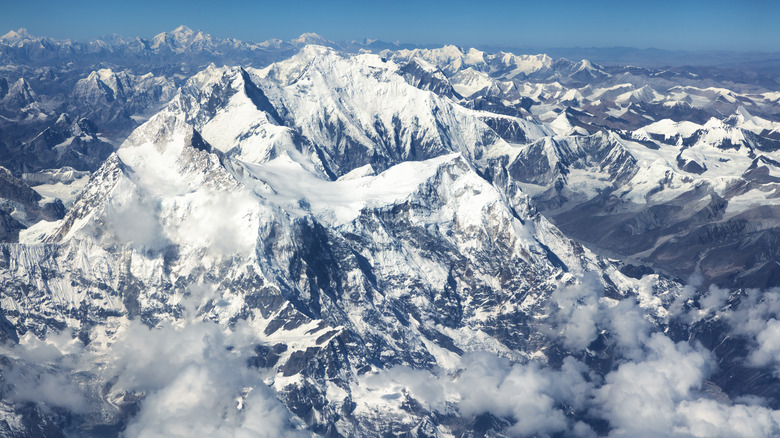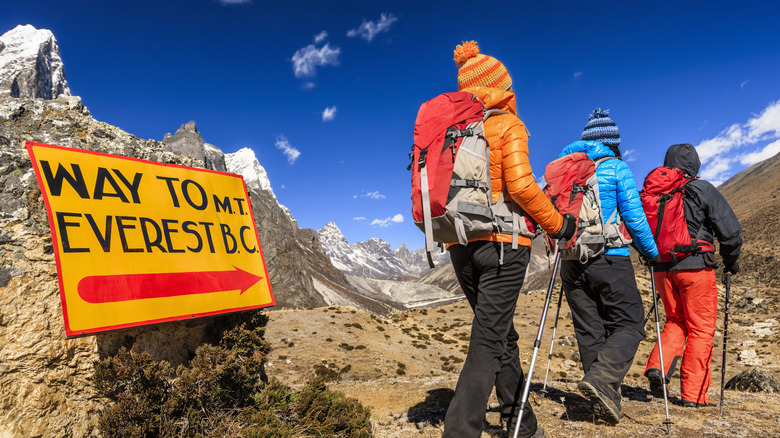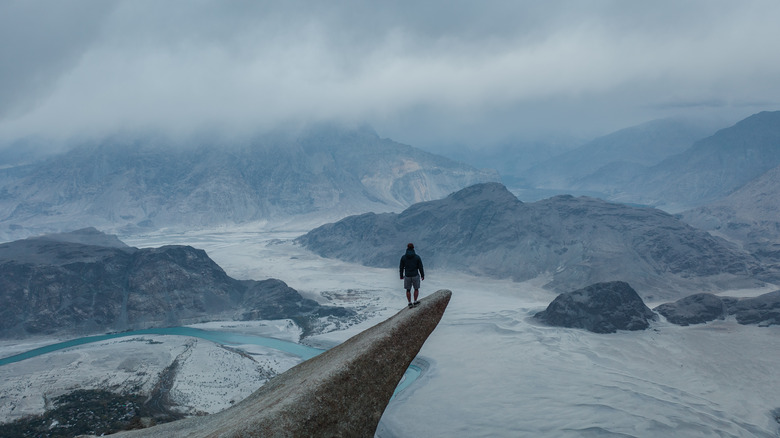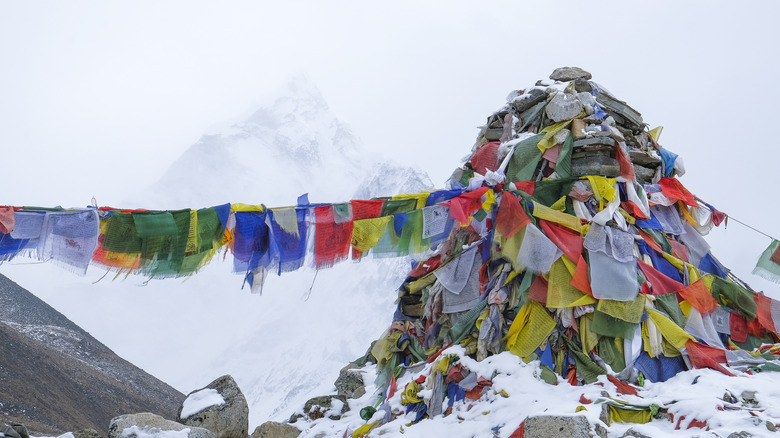How Many People Have Died Climbing Mt. Everest?
With a summit 29,032 feet above sea level, Mt. Everest invokes awe and defiance in equal measures. It's the highest point on Earth where you can stand, and it beckons people from around the globe to scale its peak and survey the world below. Maybe it's just the thrill of surmounting — literally — the most massively rocky challenge on Earth. Maybe it's a desire to ascend to a realm traditionally considered sacred and belonging to the gods, like with Mt. Fuji in Japan, Mt. Sinai in Egypt, Mt. Olympus in Greece, Nanda Devi in India, and many more. But no matter what, the privilege of beholding a peak as high as Mt. Everest requires a high price. And in many cases, that price is no less than death.
It's unlikely that Sir Edmund Hillary and Tenzing Norgay realized what a Pandora's Box they were opening when they became the first people to stand at the summit of Mt. Everest in 1953. As National Geographic tells us, they had a support team as bottom-heavy as Everest itself: 350 porters carrying a massive load of supplies, 10 climbers, and 20 Sherpas to guide them all. And now? There are five-step "how to" guides for climbing Everest on Live Science complete with gear and itinerary breakdowns. Entire businesses like Adventure Consultants specialize in taking people up Everest, assembly-line fashion. But despite such familiarity, Everest kills every year — as of November 2022, 320 are dead, per Climber News. More have died since.
The way to the top
At this point would-be ascenders of Mt. Everest can follow a rote itinerary and set path that's been pounded into the snow by thousands of climbers. That's not to say that the task is easy. You've got to be extremely healthy and train for years, especially when it comes to your cardiovascular system. Otherwise, the 70% drop in oxygen will kill you. Plus, you've got to carry months' worth of not-exactly-light equipment and supplies on your back for the entire trek up and down (yes, you've got to go back down, remember). Explorer's Passage says that it's 19 days round trip just to get to Everest Base Camp, and 40 days from there to the peak. All together, the journey takes about three months.
Climbing Everest isn't cheap, either. Aside from traveling expenses to get to Nepal and the money to not have to work for the entire journey, you need a permit to climb the mountain. A solo permit is $25,000, Live Science says. Taking all expenses into account — tent, guides, communication devices, oxygen tanks, etc. — it's about $200,000 per person.
And yet, despite all of these enormous hurdles, Explorer's Passage says that 800 people or so try the climb every year. Over 4,000 climbers have reached the top (not counting multiple ascents by the same person). The University of Washington tells us that more people try than ever, but since 1990 a steady 1% have died.
Death by the numbers
The University of Washington has an extensive breakdown of success and death rates of Mt. Everest climbers. The number of people embarking on first-time trips jumped from 2,200 per year from 1990 to 2005, to 3,600 per year from 2006 to 2019. Over 60% are successful — double that of 1990 — a number largely attributed to improved weather forecasting. Critically, those figures don't include Sherpas, photographers, etc. You can even sometimes see a colorful queue of climbers — back-to-back-to-back — along Everest's narrowest, most dangerous passage near the summit, the "death zone." With such a jam-packed crowd and a title like the "death zone," it's almost shocking that bodies don't drop from the mountainside by the hundreds.
And yet, more people climbing means more people dying. In 2019 TIME said that 11 people died that year during Everest's "summit window" (May and September). That's 11 out of 891 people who reached the summit — a 1.2% consistent with the University of Washington's death rate findings. Contrarily, Outside Online says that during the May 2023 summit window — excluding September altogether — a full 10 people died out of the 500 that reached the summit. That's not just a higher number of deaths than usual, but double the percentage. Whether because of climber bottlenecks, post-COVID overeagerness, sloppy planning, poor conditions, or something else, is unknown.
Those left behind
Because of Mt. Everest's low death rate, less people overall have died climbing the mountain than the reader might suspect. As of November 2022, Climber News reported 310 total deaths on Everest, to which we can add 10 more from May 2023. And yet, because of the number of people who've attempted the climb, more people have died on Everest than any other mountain. Perhaps more grim than the number of people who've died, however, is the amount of bodies left unretrieved. Out of the 200 or so dead who remain on the mountain, we don't know where most of them are or how they died. Only a few bodies lay within sight of climbers, unable to be collected and serving as "markers" for those making the attempt.
There is, however, a makeshift memorial to the dead along Everest's Base Camp route in Thukla Pass. As Heaven Himalaya says, the memorial sits half an hour uphill from Thukla along the way to a tiny settlement called Lobuche. Informally called "The Scott Fischer Memorial" — in honor of climber Scott Fischer who scaled Everest and other peaks without oxygen tanks in the 1970s — the memorial is basically a conical pile of rocks decorated with colorful, flag-like pieces of fabric (seen above). Sherpas, family members, or those wishing to pay respects continue to build it bit by bit. Moving into the future, let's hope fewer flags need to be left behind, along with the bodies of the dead they represent.



